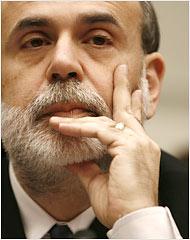Ben S. Bernanke

Federal Reserve Chairman Ben S. Bernanke, initially criticized for being too academic and slow to respond to market worries, has presided over some of the most interventionist and controversial Fed actions since the central bank’s founding in 1913.
Mr. Bernanke, a longtime economics professor at Princeton, inherited a housing market on the brink of collapse when he began his four-year term as Fed chairman in February 2006. After initially playing down concerns about housing and a potential liquidity crisis, Mr. Bernanke presided over an aggressive series of interest rate cuts that began in August 2007. Some inflation hawks attacked the rate cuts, which were intended to counteract the tight credit market and spur growth.
In March 2008, Mr. Bernanke helped engineer JPMorgan Chase’s takeover of a rival, Bear Stearns, an investment bank badly damaged by the mortgage meltdown. On the same day the takeover was announced, the Fed introduced a temporary program of low-cost overnight loans to investment banks, a privilege available to commercial banks for years. In July 2008, the Fed extended this emergency borrowing program through January 2009.
Also in July, the Fed adopted sweeping lending rules that Mr. Bernanke said were intended to reduce deceptive lending practices. With the support of the Treasury secretary, Henry M. Paulson Jr., Mr. Bernanke argued for expanding the Fed’s regulatory powers and warned that the turmoil affecting the housing and financial markets would spill deep into 2009.
In September, he supported Mr. Paulson’s move to seize Fannie Mae and Freddie Mac, the nation’s largest mortgage holders, which had been struggling with the record high foreclosure rates. With the bailout, the federal government would be in control of institutions that finance or guarantee about half of all the mortgages in the country.
Two weeks later, the central bank agreed to a $85 billion rescue of the American International Group, an insurance giant that had insured billions of dollars worth of risky mortgage-backed securities and was now on the edge of bankruptcy. Fed and Treasury officials had initially rebuffed A.I.G. executives pleaded for help, but they reversed course, fearing that A.I.G.’s collapse would cause a worldwide financial crisis.
But the rescue had little effect on the weakening confidence in the credit markets. On Sept. 18, in an extraordinary day of events, the Fed poured almost $300 billion into global credit markets and barely put a dent in the level of alarm. The next day, Mr. Paulson introduced a $700 billion plan, eventually approved by a reluctant Congress, that would allow the government to buy bad mortgage-backed securities.
Meanwhile, the Fed deployed tens of billions of dollars to shore up confidence in money market mutual funds and announced a new program to buy up companies’ unsecured debt, putting it closer than ever to the role of direct lender to business.
Mr. Bernanke, who received a B.A. in economics from Harvard and a Ph.D. in economics from M.I.T., was a professor at Princeton from 1985 to 2005 (with a leave starting in 2002). Before being named Fed chairman, he served as a member of the board of governors of the Federal Reserve System (2002 to 2005) and as chairman of President Bush’s Council of Economic Advisers (from 2005 to 2006). When sworn in as Fed chairman in 2006, he was also appointed to a 14-year term as a member of the board.
On Feb. 18, 2009, Mr. Bernanke defended the central bank's efforts and tried to allay concerns that it had been printing money at a dangerous pace. He was speaking at the National Press Club, the first time that a Fed chairman had taken questions from journalists in a public forum.
"The Federal Reserve has done, and will continue to do, everything possible within the limits of its authority to assist in restoring our nation to financial stability," he said.
Mr. Bernanke made it clear that he supported a stimulus package of increased spending and tax cuts, though he declined to comment on the particulars of the measure signed on Feb. 17 by President Obama.
Mr. Bernanke focused his remarks on the Fed's expansion of lending activities since last fall. Using its power to create additional money at will, the central bank has more than doubled its "balance sheet" of holdings to about $2 trillion, from $900 billion since last September.
Acknowledging that some experts had raised fears that the Fed would end up stoking inflation, or losing money on risky loans, Mr. Bernanke argued that the central bank would be able to reverse course fairly swiftly as soon as the crisis abated.
